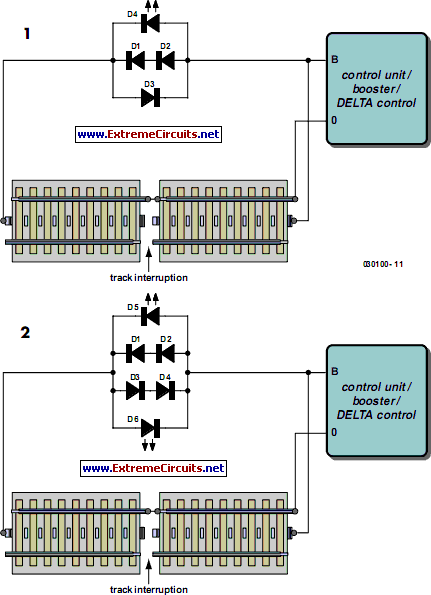Home » Circuits
Pseudo Track Occupancy Detector
Track occupancy detectors are needed for hidden yards and other sections of track that are hard to see, but they are also necessary for block operation. The circuit described here uses an LED to indicate track occupancy for digitally controlled Märklin HO model train systems (including Delta Control). In contrast to a real track occupancy detector, which detects all vehicles, it only responds to vehicles that draw traction current. This means it can be used without making complicated modifications to the rolling stock and track, since it is only necessary to gap the third rail. This circuit is thus especially suitable for retrofitting to existing installations, and it is equally well suited to M, K and C tracks.The basic idea of the circuit is simple. If a locomotive enters the monitored track section, a current flows through the motor. This current is sensed and generates an indication. With a Märklin Digital system, power is provided to the locomotive via a controller or a booster in the form of a square-wave voltage. The voltage levels on the rails are approximately –15 V and +15 V. Digital control information is transferred by a continuous sequence of alternating plus and minus levels. This means that the detector circuit must be able to respond to AC signals. In Figure 1, the monitored track section on the left is connected to the ground terminal ‘0’ via the rails.
Circuit diagram:
The third rail, with conducts the traction current to the locomotive, is isolated from the rest of the system (special third-rail insulators are available for this purpose), and it is connected to the ‘B’ terminal of the controller or booster via the detector circuit. If a locomotive travels over the monitored track section, the positive component of the drive current flows through diodes D1 and D2, while the negative component flows through D3. With a motor current of approximately 250 mA, the voltage drop across a single diode (1N4001 types are used here) is a good 1 V. The voltage drop across the two diodes connected in series (D1 and D2) is sufficient to illuminate LED1. Although the locomotive will travel somewhat slower due to the voltage drop, this will not cause any problems.
A second detector can be obtained by connecting an additional diode to the circuit as shown in Figure 2. This causes a second LED to illuminate for negative drive current. Due to the pulse trains and fluctuations in the traction current, the LED illumination is not constant, but instead flickers more or less strongly. Other traction-power loads, such as coach lighting or taillights, will also generate an ‘occupied’ indication. In such cases, the LED will remain illuminated even if the locomotive is standing still with no current flowing through the motor. Sometimes the quiescent current through a decoder is sufficient to cause the LED to illuminate (a little bit) even if the locomotive is standing still. Another possibility is to use an optocoupler instead of an LED. This would allow the circuit to be connected to an s88 detection module.
Author: Nils Körber - Copyright: Elektor July-August 2004

